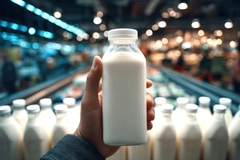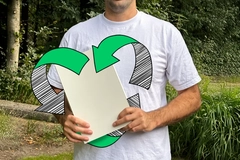Microplastic debris on seafloors triple in 20 years, find researchers
 Researcher Laura Simon-Sánchez during one of the sample collection campaigns (Image credit: Lena Heins).
Researcher Laura Simon-Sánchez during one of the sample collection campaigns (Image credit: Lena Heins). 05 Jan 2023 --- The amount of microplastics collected on ocean floors has tripled in the past 20 years at the same rate of social plastic consumption, according to research by the Institute of Environmental Science and Technology of the Universitat Autònoma de Barcelona (ICTA-UAB) and the Department of the Built Environment of Aalborg University (AAU-BUILD).
The study provides the first high-resolution reconstruction of microplastic pollution from sediments obtained in the northwestern Mediterranean Sea by combining a palaeoceanographic approach and state-of-the-art analytical methods for microplastic identification.
Despite scientists assuming the seafloor is the final sink for plastics floating on ocean surfaces, the pollution rate was previously unknown.
The study, published in the journal Environmental Science and Technology, shows that microplastics are retained unaltered in marine sediments, and that the amount of microplastic sequestered in the seafloor mimics the rate of global plastic production from 1965 to 2016.
“Specifically, the results show that, since 2000, the amount of plastic particles deposited on the seafloor has tripled and that, far from decreasing, the accumulation has not stopped growing, mimicking the production and global use of these materials,” explains ICTA-UAB researcher Laura Simon-Sánchez. Microplastics no longer degrade once they reach the seafloor, the study shows.
Microplastics no longer degrade once they reach the seafloor, the study shows.
Microplastics building
The research team investigated sediment collected in November 2019 on board the oceanographic vessel Sarmiento de Gamboa in an expedition from Barcelona to the coast of the Ebro Delta in Tarragona, Spain.
The group selected the western Mediterranean Sea as a study area – particularly the Ebro Delta – because rivers are recognized as hotspots for several pollutants, including microplastics. In addition, the influx of sediment from the Ebro River provides higher sedimentation rates than in the open ocean.
The sediments analyzed have remained unaltered on the seafloor since they were deposited decades ago. “This has allowed us to see how, since the 1980s, but especially in the past two decades, the accumulation of PE and PP particles from packaging, bottles and food films has increased, as well as polyester from synthetic fibers in clothing fabrics,” explains Michael Grelaud, ICTA-UAB researcher.
The amount of these three types of particles reaches 1.5 mg per kg of sediment collected, with PP being the most abundant, followed by PE and polyester. Despite awareness campaigns and policy shifts to reduce single-use plastic, the researchers say the findings show that current efforts are insufficient to tackle ocean pollution.
New research methods
Although smaller microplastics are very abundant in the environment, constraints in analytical methods have limited evidence on the levels of small microplastics in previous studies targeting marine sediment. The new study methods applied state-of-the-art imaging to quantify particles down to 11 µm in size.
Once microplastics are trapped in the seafloor, the imaging shows that the particles no longer degrade, either due to lack of erosion, oxygen or light.
“The process of fragmentation takes place mostly in the beach sediments, on the sea surface or in the water column. Once deposited, degradation is minimal, so plastics from the 1960s remain on the seabed, leaving the signature of human pollution there,” says Patrizia Ziveri, ICREA professor at ICTA-UAB.
Microplastics have been discovered in many of the most remote areas of the world, including Antarctic snow and on Mount Everest. However, some researchers also claim that the levels of microplastics discovered are usually non-toxic.
By Louis Gore-Langton











